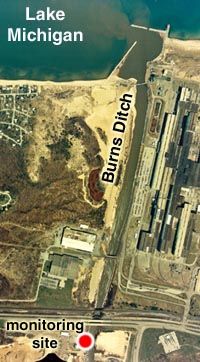
Map showing land uses within the Little Calumet watershed.
In cooperation with the Biological Research Division of the U.S. Geological Survey (USGS), the Department of Geological Sciences of Indiana University (IU) and the Indiana Geological and Water Survey (IGWS) initiated a project to develop a basis for forecasting outfalls of E. coli into Lake Michigan from the Little Calumet watershed, which is the largest watershed that contributes bacterially contaminated streamflow to Indiana's southern Lake Michigan shoreline. The project was sponsored by the U.S. Environmental Protection Agency (EPA), Region 5, Water Division. The term of the study was from September 1, 1998, to June 30, 2000.
PROJECT SCOPE AND CHRONOLOGY

The monitoring site is at the end of a dock at Lefty's Landing, just off U.S. Highway 12. Note the plume discharging from Burns Ditch into Lake Michigan.
The project involved installation of electronic sensors for continuous measurement of water quality parameters near the outlet of the Portage-Burns Waterway (referred to here as "Burns Ditch") and intensive sampling for E. coli bacteria during four separate 24-hour periods. A goal of the project was to begin development of an early warning system for forecasting beach closures due to high bacteria concentrations in lake water. The Burns Ditch location was chosen because it is the outfall point for the largest watershed (Little Calumet drainage) contributing contaminated streamflow to Indiana's southern Lake Michigan shoreline. Determining the relationships that exist between E. coli and water quality, weather conditions, and flow was necessary as a foundation for understanding seasonal and storm-period variations of bacterial outfalls to the lake. The data collected from Burns Ditch will be used in conjunction with data from similar monitoring stations in the Derby Ditch drainage to evaluate short-term temporal trends of E. coli concentrations in streamflow. Simultaneous monitoring of water-quality parameters using electronic sensors has facilitated the evaluation of statistical relationships between bacterially contaminated streamflow and readily measured surrogate variables such as dissolved oxygen, temperature, and turbidity. If such relationships can be demonstrated to hold for the entire lake-rim region over an extended period, then electronic monitoring of the surrogate water-quality parameters can be used to continuously and accurately track levels of E. coli.
In April 1999, a monitoring station was established on the pier at Lefty's Landing, where Burns Ditch flows under U.S. Highway 12 in Portage, Indiana. Data collection commenced on April 22, 1999, and the site was visited twice monthly (except during the winter) for routine servicing and calibration checks through June 2000.
CONCLUSIONS
Concentrations of E. coli in streamflow at the outlet of Burns Ditch during storms do not show any consistent relationship to stream discharge, but the values of E. coli concentrations at any time during a storm period are highly correlated to previous concentrations. This indicates that the bacteria move through the stream system as distinct contaminant plumes.
Concentrations of E. coli in samples of streamflow collected at the outlet of Burns Ditch using the traditional grab method show a nearly one-to-one correspondence with concentrations in samples collected using autosamplers. This indicates that the use of autosamplers does not result in cross-contamination of successive samples taken during storm events.
There is a strong statistical correlation between values of E. coli concentrations in streamflow at the outlet of Burns Ditch and the total suspended solids (TSS) in the flow. The relationship between bacterial concentrations and the organic fraction of the TSS is also statistically significant, but the direction of the correlation is negative. This seems to indicate that the bacteria are not adhering preferentially to organic sediments.
Concentrations of E. coli in streamflow at the outlet of Burns Ditch seem at all times to be statistically correlated with water-quality parameters that can be continuously monitoring using electronic water-quality sensors. Such relationships, should they prove to be reproducible at other sites within the lake-rim area, may provide the most accurate basis for forecasting bacterial concentrations on a real-time basis.
For additional information, you may contact either Greg Olyphant (e-mail: olyphant@indiana.edu) at the Department of Geological Sciences, Indiana University, Bloomington, IN 47405, or Denver Harper (e-mail: dharper@indiana.edu) at the Indiana Geological Survey, 1001 E. 10th St., Bloomington, IN 47405-1405


